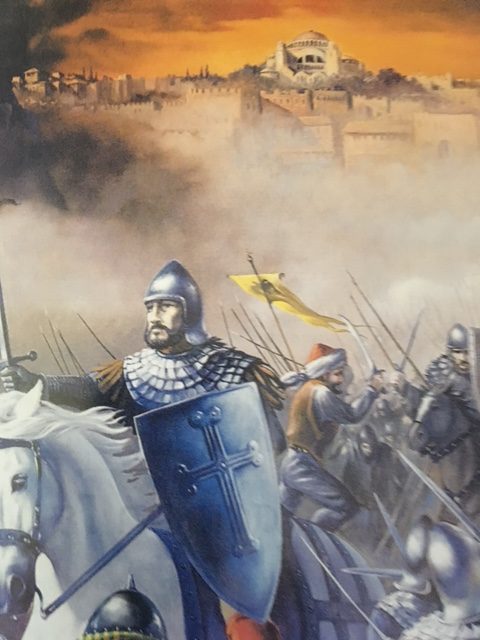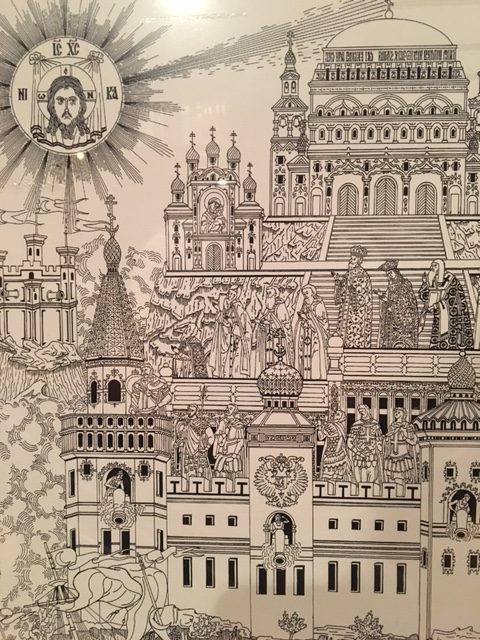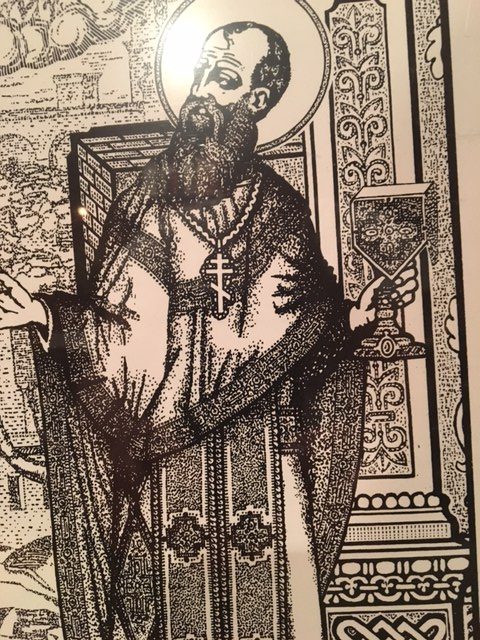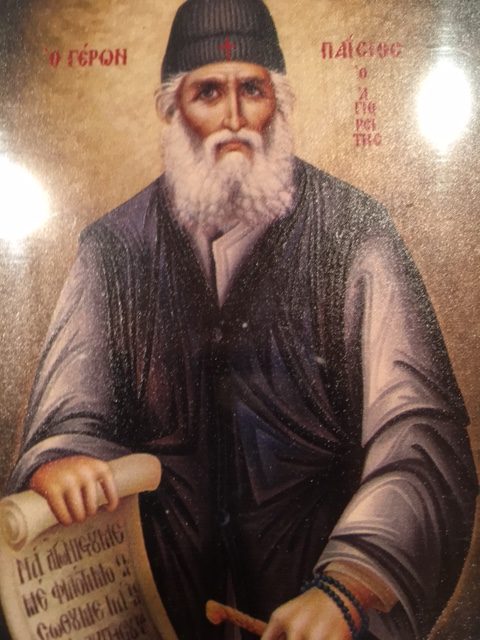On 29 May 1453, the glorious capital of Christendom fell to the Ottoman Turks after a heroic fifty five day resistance. Constantine XI Paleologos fought to the end after refusing all entreaties throughout the siege to save himself and leave the City. In an exchange with Sultan Mehmet during the siege he defiantly declared, “To surrender the city is not for me to do, nor anyone else who inhabits it; because it is our common decision to die voluntarily and not to spare our lives.”

The last Emperor was an honorable but tragic figure. He was twice widowed and left no heir. He was a man of character who came to the throne when the city was long past its glory. Constantine was governor at Mystra when he learned of the death of his brother John who was Emperor in 1448. Because of the tensions at Constantinople owing to John’s acceptance of the heretical Council of Florence in 1439, Constantine could not be crowned at Hagia Sophia. He was crowned at the Church of Saint Demetrios at Mystra.
In 1451, a new Sultan came to the throne of the Ottoman Empire which was then at Adrianople. Mehmet II was only nineteen years old and was known for his ruthlessness and ambition. The city was in his sights for the glory of Islam.
Constantinople was inaugurated in the year 330 AD by Constantine the Great, the first Christian Emperor. Constantine was the Roman Emperor who legalized Christianity and who presided over the First Ecumenical Council of Nicea in 325 AD which condemned the heresy of a priest named Arius and established Orthodox teaching that the father and son within the trinity were of one essence and being and that the second person of the trinity the incarnate logos and word of God was not a creature as Arius had been teaching.
Constantine the Great set in motion the new Christianized Empire which would last for over eleven centuries. Over the centuries, the Empire would be divided by numerous heretical teachings that arose. Ecumenical as well as lesser councils would be convened to clarify what was Orthodox and to condemn heresies and their proponents. Such heresies included nestorianism, monophysitism, and iconoclasm.
Constantinople became well known for its Cathedrals and Churches. In 537 AD, the Cathedral of Hagia Sophia was consecrated under the auspices of the Emperor and theologian Justinian the Great. Justinian presided over the Fifth Ecumenical Council that affirmed the decisions of the Fourth Ecumenical Council one century earlier that taught that Jesus Christ had two natures human and divine, he was both God and man.
Constantinople became a place of learning and culture. The City preserved texts in its splendid libraries from classical Greece and Rome. It produced a few heretics but more Saints such as Photius the Great in the ninth century. Saint Photius followed Saints Gregory the theologian, John Chrysostom, and John the Faster on the Patriarchal throne.
Like the early Church fathers, Photios the Great was a staunch teacher of Orthodoxy that sought to correct the errors of the Latins in Rome. He protested the addition to the creed (the filioque) by Rome which asserted the Holy spirit proceeded from both the father and the son. This was in complete defiance of three ecumenical councils which prohibited any alterations to the creed and it confused the hypostasis of the father with the son.
In 1054, the Latins formally left the Church when they arrogantly threw a bull of excommunication on the altar of Hagia Sophia supposedly excommunicating the Greeks.
Previous to this in 988 AD under the Emperor Basil II Russia was converted to Christianity,
“When we journeyed among the Bulgarians we beheld how they worship in their temple, called a Mosque while they stand ungirt. The Bulgarian bows, sits down, looks hither and thither like one possessed, and there is no happiness among them but instead only sorrow and a dreadful stench. Their religion is not good. Then we went among the Germans, and saw them performing many ceremonies in their temples; but we beheld no glory there. Then we went to Greece, and the Greeks led us to the edifices where they worship their God, and we knew not whether we were in heavan or on earth. For on earth there is no such splendor or such beauty, and we are at a loss how to describe it. We know only that God dwells there among men, and their service is fairer than the ceremonies of other nations. For we cannot forget that beauty.” Russian envoys report to Prince Vladimir Medieval Russia’s epics, chronicals, and tales |
In August 1071, an event occurred that has cursed the Greek world up to the present time. The Battle of Manzikert led to the Seljuk Turks defeating the Eastern Roman (Greek) Empire and conquering many of the eastern territories. This not only created a security threat but it deprived Constantinople of important sources for taxation.
In 1095, Emperor Alexios Comnenus with the best of intentions asked for mercenaries from the west to help defeat and turn back the Seljuk Turks. In response, the Pope created the concept of the Crusades. Over 100,000 angry Crusaders arrived at Constantinople.
The Latins arrived and were astonished by the glorious city of Constantinople. The Greek city was full of spiritual and cultural treasures which were lacking in the west. They were further confused by the inability of the Greeks to comprehend the idea of “holy war”. The Greeks explained to them that their wars were imperial wars and while the Church blessed the Emperor and the army it did not bless the killing of people itself.
By 1187, the Crusaders were driven from the holy land. A subsequent Crusade intended for Jerusalem was in effect diverted to Constantinople by the stupidity of a Greek named Isaac Angelus who claimed authority that he did not have and offered them funds the treasury of the empire did not have. It ended badly when the Crusaders attacked and destroyed Constantinople and confiscated its wealth while perpetrating massacres and destroying Churches. The Latins occupied Constantinople from 1204 until its liberation in 1261.
By this time Constantinople was in irreversible decline. Theology was still important for the Greeks as can be seen by the Palamite councils of 1341 and 1351 which exonerated the teachings of Saint Gregory Palamas and his teaching on “hesychasm”, a mystical form of prayer. By the end of the fourteenth century, the Ottomans for the first time attempted to conquer Constantinople.
Emperor Manuel II Paleologos travelled to England and France to obtain European support but to no avail. He returned to his city with nothing to show for his troubles. The second Ottoman attempt to take Constantinople occurred in 1422 but ended in failure.
At this point, the Greeks were desperate and in times of desperation people turn to desperate measures. Emperor John Paleologos sought survival through the union of the Greek Church with the Latins. This was too much for the Orthodox party that found such a solution intolerable. A Monk later known as Saint Mark of Ephesus emerged as the leader of the opposition.
Saint Mark was elevated to the status of bishop in order to attend the Council of Florence and negotiate with the Latins. The other Bishops having been intimidated by the Emperor agreed to union with the Latins although the latter failed to repent of their heretical doctrines. Saint Mark alone refused to sign and returned to Constantinople.
In Constantinople, the people of the city responded in anger at the news that the bishops betrayed Orthodoxy. Riots and protests broke out. All this was in the background when Emperor John died and his brother Constantine was called to take up the throne of Constantinople. The Megaduke Lucas Notaras declared, “better the turban of the Sultan than the cardinal’s hat”.
Sultan Mehmet began the siege in the first days of April. Two thousand Italians from Venice and Genoa had arrived to fight for the city. Considering that the Greeks had five thousand soldiers who could fight and the Sultan had an army of eighty thousand, this was not enough. So much for the efforts of the unionists.

Whatever else can be said, the Greeks fought valiantly, and the Italians who arrived deserve admiration particularly the General Giustiniani. The Greeks fought hard and they frustrated the Ottomans. The elderly and others contributed by bringing food and water to the soldiers defending the walls of the city.
During the siege of the city, priests led a procession carrying the icon of the Most holy theotokos. The icon fell to the ground and broke. This was seen as a terrible sign of things to come. The Emperor himself maintained his composure and remained optimistic throughout the siege.
Near the end the Emperor’s military ally, Giustiani was wounded by the Turks and he lost his nerve and returned to his ship to depart. Earlier, the Turks had purchased cannons from a man named Orban. He had originally offered the sale to the Greeks but the latter could not afford it. The great walls of the city that had saved it and its inhabitants so often in the past were devastated by the cannons.
On the eve before the fall of the city, the Emperor entered Hagia Sophia to receive holy communion for the last time. He expressed remorse to all those who he may have offended. With great humility he received the holy gifts.
On the early morning of 29 May 1453 the Emperor spoke offering encouragement to his troops. Off to battle he went for the last time and fell as a common soldier having thrown off the royal purple. The city had fallen!
“The Christian troops had been waiting silently; but when the watchmen on the towers gave the alarm the Churches near the wall began to ring their bells, and Church after Church throughout the City took up the warning sound until every belfry was clanging. Three miles away, in the Church of the Holy Wisdom the worshippers knew that the battle had begun. Every man of fighting age returned to his post; and women, nuns amongst them hurried to the walls to help bring up stones and beams to strengthen the defenses and pails of water to strengthen the defenses. Old folk and children came out of their houses and crowded into the Churches, trusting that the Saints and Angels would protect them.”
The Fall of Constantinople 1453 by Sir Steven Runciman
The following eyewitness account comes from George Sphrantzes the official and friend of the Emperor,
“As soon as the Turks were inside the City, they began to seize and enslave every person who came their way, all those who tried to offer resistance were put to the sword. In many places the ground could not be seen, as it was covered by heaps of corpses. There were unprecedented events: all sorts of lamentations, countless rows of slaves consisting of noble ladies, virgins, and nuns, who were being dragged by the Turks by their headgear, hair, and braids out of the shelter of Churches, to the acompaniment of mourning. There was the crying of children, the looting of our sacred and holy buildings. What horror can such sounds cause! The Turks did not hesitate to trample over the body and blood of Christ poured all over the ground and were passing his precious vessels from hand to hand;
“Christ our Lord, how inscrutable and incomprehensible your wise judgements! Our greatest and holiest Church of Saint Sophia, the earthly heaven, the throne of God’s glory, the vehicle of the cherubim and second firmament, God’s creation, such edifice and monument, the joy of all earth, the beautiful and more beautiful than the beautiful, became a place of feasting; its inner sanctum was turned into a dining room; its holy altars supported food and wine, and were also employed in the enactment of their perversions with our women, virgins, and children. Who could have been so insensitive as not to wail Holy Church?
The above account comes from “The Fall of the Byzantine Empire A Chronicle by George Sphrantzes 1401-1477 Translated by Marios Phillipides
The slaughter proceeded for three days without ceasing. Before the onset of hostilities, Sultan Mehmet had offered the Greeks a choice. Surrender peacefully and the inhabitants and their families and possessions would remain unmolested. Convert to Islam, or fight and suffer the consequences in which three days of pillage would ensue. The Empire Constantine and the people of the city chose to fight.
The following passage pertains to the horrible fate suffered by the Grand Duke Lukas Notaras and his family. The quote comes from Franz Babinger’s “Mehmed the Conqueror and his Time:”
” the Sultan prepared a great banquet near the imperial Palace. Drunk with wine, he ordered the chief of the black eunuchs to go to the grand duke’s home and bring back his youngest son, a handsome lad of fourteen. When the order was transmitted to the boy’s father, he refused to comply, saying he would rather be beheaded than allow his son to be dishonored. With this reply, the eunuch returned to the sultan, who sent the executioner to bring him the duke and his sons. Notaras took leave of his wife and accompanied by his eldest son and his son in law Cantacuzenos, followed the executioner. The sultan ordered all three beheaded. The three heads were brought to the Sultan; the bodies remained unburied. Notaras, popularly known as the “pillar of the Rhomaioi (Romans) had once declared “Rather the Turkish Turban in the City than the Roman miteir”. His wish had been fulfilled”.
In the aftermath the Greeks lamented the passing of the city and the death and martyrdom of Constantine XI Paleologos. The legacy of Constantine lives on in music, poems, children’s tales. The best known tale is that of the “Marble “emperor”. The children were taught that the Emperor had not died. An angel had taken him in the moments before the final battle and that Constantine sleeps awaiting the moment when the angel will return to bring him his golden sword so that he can liberate his city.

There is another tale that is told of the mysterious priest in Hagia Sophia. The story is told that when the liturgy was interrupted by the Turks, the walls of the Church opened and the priest was taken inside only to return on the day when Hagia Sophia serves as a Church again.

In 1589, Ecumenical Patriarch Jeremias II made a visit to Russia and recognized both the autocephaly of the Russian Orthodox Church (originally proclaimed in 1448 after the council of Florence) and the upgrading of the status of the Metropolitan of Moscow to Patriarch. Russia emerged as the successor to the Eastern Roman (Byzantine) Empire.
In the centuries to come, there were plans for the liberation of Constantinople. Russian ruler Catherine the Great (1762-1796) espoused the idea of a “Greek project” in which an independent Greece would be formed with Constantinople as its capital. Although nothing came of this idea, the Russians intervened on behalf of the Christians of the Ottoman Empire. In 1774, Catherine’s armies smashed the Ottoman Empire and forced the Turks to sign the “Treaty of Kachuk Kanarji” which required equal treatment of Christians with Muslims.
In 1853, the Russian Empire declared war on the Ottoman Empire over the status of the holy places in Palestine. The Roman Catholics were challenging Greek Orthodox control of the shrines. Great Britain and France intervened on behalf of the Turks. Were if not for western treachery, Constantinople might have been liberated.
In 1919 after the victories of Greece in the Balkan Wars and the first world war, Athens was supported in her claims to Smyrna and other territories in Asia Minor. The downfall of Greek Prime Minister Eleutherios Venizelos and the restoration of the Danish-German monarchy in Athens complicated Greek relations with the west. The western powers armed and supported the Turks. The Turks regained Constantinople and Asia Minor.
Since that time, the Greek population in Constantinople has been the victim of ethnic cleansing. The last heirs of Constantine XI Paleologos are almost gone. After the 1955 pogroms in Constantinople and the ethnic cleansing campaign of 1964 and after the Greek Orthodox of Constantinople were reduced to a mere two thousand.
The city left behind an immense spiritual legacy. Its spiritual influence can be seen on today’s Russia which displays the double headed eagle and champions Orthodoxy.
In our own day, Hagia Sophia is under threat. The government of Turkey wishes to turn the Church (currently a museum) into a Mosque. There are those of us who have fought, and will continue to fight to ensure this does not happen.
The passing of Constantinople continues to be mourned by Greeks. While we lament the passing of the city and the heroic martyrdom of Constantine and the defenders and the people of the city, we Greeks must reflect on the lessons not yet learned. We have failed to learn from the treachery of the Fourth Crusade and the Council of Florence, and very unpleasant events are taking place as a result of recent initiatives of the Church of Constantinople whose position in his city remains as precarious as ever.
In any case, some of us have looked upon prophecies attributed to Saint Cosmas of Aetolia and Saint Paisios of Mount Athos with great interest. These two saints lived in the eighteenth and twentieth centuries respectively. They are known for their love of Christ and their enormous piety. It is said that they have predicted things that have already come to pass.
They have also predicted that Constantinople will be liberated.


